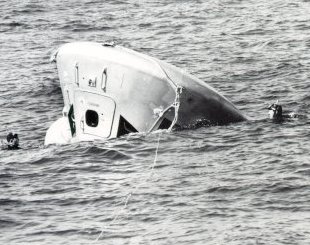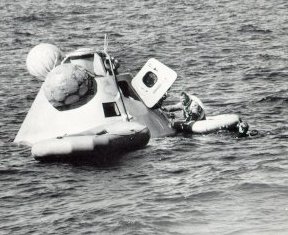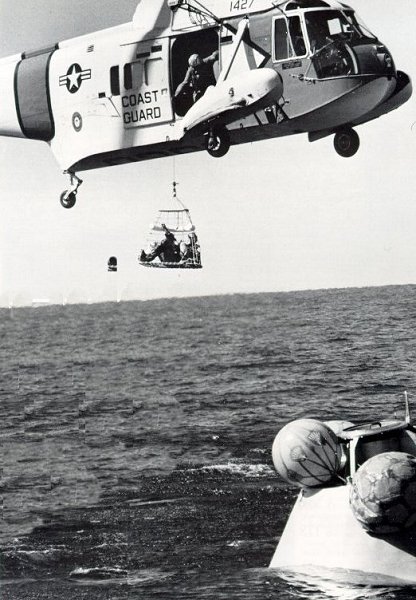Apollo Expeditions to the Moon
A SUPERB SPACECRAFT
During the 163 orbits of Apollo 7 the ghost of Apollo 204 was effectively exorcised
as the new Block II spacecraft and its millions of parts performed superbly. Durability
was shown for 10.8 days - longer than a journey to the Moon and back. A
momentary shudder went through Mission Control when both AC buses dropped out
of the spacecraft's electrical system, coincident with automatic cycles of the cryogenic
oxygen tank fans and heaters; but manual resetting of the AC bus breakers restored
normal service. Three of the five spacecraft windows fogged because of improperly
cured sealant compound (a condition that could not be fixed until Apollo 9). Chargers
for the batteries needed for reentry (after fuel cells departed with the SM) returned
50 to 75 percent less energy than expected. Most serious was the overheating of fuel
cells, which might have failed when the spacecraft was too far from Earth to return on
batteries, even if fully charged. But each of these anomalies was satisfactorily checked
out before Apollo 8 flew.
| | |
Gag card is held before TV
camera by
Apollo 7 Commander
Wally Schirra during
third day of the first
manned Apollo mission.
CM pilot Donn Eisele
looks on. TV coverage
using the small, hand-held
camera was to have
begun on the second
day but minor tasks used
more than the expected
time. Another sign displayed
during the nation-wide
broadcast greeted
viewers from "the lovely
Apollo room high atop
everything".
|
The CSM's service propulsion system, which had to fire the CSM into and out of
Moon orbit, worked perfectly during eight burns lasting from half a second to 67.6
seconds. Apollo's flotation bags had their first try-out when the spacecraft, a "lousy
boat", splashed down south of Bermuda and turned upside down; when inflated, the
brightly colored bags flipped it aright.
In retrospect it seems inconceivable, but serious debate ensued in NASA councils
on whether television should be broadcast from Apollo missions, and the decision
to carry the little 4 1/2-pound camera was not made until just before this October flight.
Although these early pictures were crude, I think it was informative for the public to
see astronauts floating weightlessly in their roomy spacecraft, snatching floating objects,
and eating the first hot food consumed in space. Like the television pictures, the food
improved in later missions.
| | |
"Stable two", an engineering euphemism for
upside-down, was one of the ways that the command
module could float and this was the way that
Apollo 7 splashed down. The astronauts
hung from their restraining belts for a few
minutes until three righting bags were inflated to
flip the spacecraft. The photo sequence above
and below, not the actual Apollo 7 landing,
shows a training session, one of many constantly
held to drill recovery teams and astronauts.
Not used in this exercise was the flotation collar,
normally fixed around the command module,
that provided insurance against swamping from
water taken aboard through the open hatch.
|
Apollo 7's achievement led to a rapid review of Apollo 8's options. The Apollo 7
astronauts went through six days of debriefing for the benefit of Apollo 8, and on
October 28 the Manned Space Flight Management Council chaired by Mueller met at
MSC, investigating every phase of the forthcoming mission. Next day came a lengthy
systems review of Apollo 8's Spacecraft 103. Paine made the go/no-go review of lunar
orbit on November 11 at NASA Headquarters in Washington. By this time nearly
all the skeptics bad become converts.
At the end of this climactic meeting Mueller put a recommendation for lunar
orbit into writing, and Paine approved it. He telephoned the decision to the White
House, and the message was laid on President Johnson's desk while he was conferring
with Richard M. Nixon, elected his successor six days earlier.
|





